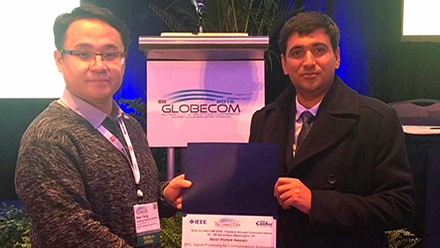Engineers at the Australian National University (ANU) are undertaking award-winning research to ensure wireless networks of the future are fast, reliable and can support an increasing number of users.
Dr Nan Yang, Associate Professor Parastoo Sadeghi, Professor Rodney Kennedy and engineering PhD student Noman Akbar from the Communications and Signal Processing Research Area at ANU have designed new algorithms to unlock the potential of communication networks with a massive number of antennas.
“In the future, we will be using 5G wireless networks, and more devices will be connecting to these networks – including home appliances. These networks will need to be able to support higher usage rates, so the quality must be improved to make them more reliable.
“We’ve developed an innovative way to design certain network parameters so this service quality can be significantly improved. We do this through the use of a large number of antennas. These antennas will be able to support a huge number of users and ensure they can all stay connected.”
This research has been published in a paper that won the Best Paper Award at the recent Institute of Electrical and Electronics Engineers (IEEE) Global Communications Conference (GLOBECOM) 2016 in Washington DC, USA.
IEEE is the world’s largest technical professional organisation. As the flagship conference for the institute, GLOBECOM is a significant scientific event, attended by scientists and researchers from both industry and academia.
Mr Akbar and Dr Yang are delighted with the result.
“This is the second time our research group has received an award at a top conference. It highlights my research abilities as a PhD student, and helps to put me on the map within the community,” said Mr Akbar. “This award provides recognition within the community that we have generated significant, original scientific contributions to massive multi-antenna systems. We have already received interest from other research institutions, in both Australia and overseas, who would like to collaborate with us,” added Dr Yang. Further information about the research and the paper, User load analysis and pilot sequence design for multi-cell massive MIMO networks, can be found here.

